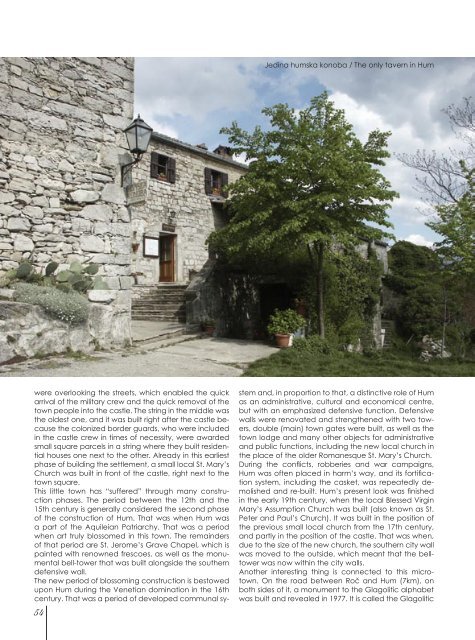100% DESIGN LONDON - DalCasa
100% DESIGN LONDON - DalCasa
100% DESIGN LONDON - DalCasa
Create successful ePaper yourself
Turn your PDF publications into a flip-book with our unique Google optimized e-Paper software.
Jedina humska konoba / The only tavern in Hum<br />
54<br />
were overlooking the streets, which enabled the quick<br />
arrival of the military crew and the quick removal of the<br />
town people into the castle. The string in the middle was<br />
the oldest one, and it was built right after the castle because<br />
the colonized border guards, who were included<br />
in the castle crew in times of necessity, were awarded<br />
small square parcels in a string where they built residential<br />
houses one next to the other. Already in this earliest<br />
phase of building the settlement, a small local St. Mary’s<br />
Church was built in front of the castle, right next to the<br />
town square.<br />
This little town has “suffered” through many construction<br />
phases. The period between the 12th and the<br />
15th century is generally considered the second phase<br />
of the construction of Hum. That was when Hum was<br />
a part of the Aquileian Patriarchy. That was a period<br />
when art truly blossomed in this town. The remainders<br />
of that period are St. Jerome’s Grave Chapel, which is<br />
painted with renowned frescoes, as well as the monumental<br />
bell-tower that was built alongside the southern<br />
defensive wall.<br />
The new period of blossoming construction is bestowed<br />
upon Hum during the Venetian domination in the 16th<br />
century. That was a period of developed communal system<br />
and, in proportion to that, a distinctive role of Hum<br />
as an administrative, cultural and economical centre,<br />
but with an emphasized defensive function. Defensive<br />
walls were renovated and strengthened with two towers,<br />
double (main) town gates were built, as well as the<br />
town lodge and many other objects for administrative<br />
and public functions, including the new local church in<br />
the place of the older Romanesque St. Mary’s Church.<br />
During the conflicts, robberies and war campaigns,<br />
Hum was often placed in harm’s way, and its fortification<br />
system, including the casket, was repeatedly demolished<br />
and re-built. Hum’s present look was finished<br />
in the early 19th century, when the local Blessed Virgin<br />
Mary’s Assumption Church was built (also known as St.<br />
Peter and Paul’s Church). It was built in the position of<br />
the previous small local church from the 17th century,<br />
and partly in the position of the castle. That was when,<br />
due to the size of the new church, the southern city wall<br />
was moved to the outside, which meant that the belltower<br />
was now within the city walls.<br />
Another interesting thing is connected to this microtown.<br />
On the road between Roč and Hum (7km), on<br />
both sides of it, a monument to the Glagolitic alphabet<br />
was built and revealed in 1977. It is called the Glagolitic
















